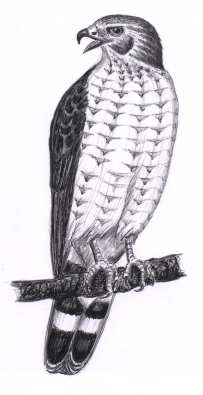
Dear Bird Folks,
I work at the Orleans Retirement Center and right outside one of our windows a large hawk has built a nest. We have been arguing as to what kind of hawk it is. Is there any chance you could stop by and identify this hawk for us?
– Nurse, Linda
Yes, Nurse Linda,
I would love to check out your hawk nest. Wait right there, I’m on my way. I’ll be over in five minutes, or six hours, if that endless Fourth of July parade is still going on in Orleans Center.
I’m back. The parade was, indeed, over and I got to see that hawk nest of yours. What a great view. I got to see two young hawklets peeking over the top of the nest, looking down at the world below. And even though I never got to see any adult hawks around, I could hear a bird calling from a nearby tree. The call that I heard was very loud and sounded something like “pweeee,” but don’t quote me. The loud call is that of a broad-winged hawk, so my guess is that’s who is nesting at your retirement center. But without seeing an adult bird, I couldn’t be sure, so I contacted the legendary bird photographer, Roger Everett, for confirmation. I’ve learned over the years that Roger will go anywhere to photograph a bird, as long as you give him good directions and offer him a plate of brownies. Roger jumped at the chance to photograph nesting hawks. After staking out the nest for two straight days (Roger has more free time than most of us), Roger and his camera confirmed that there is a nest of broad-winged hawks nesting at the Orleans Retirment Center. Cool beans.
Broad-wings are a common, crow-sized hawk, that historically have been a sporadic nester here on Cape Cod. The Cape’s wimpy little pitch pines do not provide proper nesting requirements for broad-wings. Broad-wings like older trees that are more mature, and as we all know there is a great need for more maturity on many parts of Cape Cod. Nesting near people is common for broad-wings. But even though they nest near us, they are more secretive than most hawks. They tend to hide in the foliage of the big trees and often go unnoticed. They only come out to look for prey, which includes mice, frogs, and sometimes even small birds (but I don’t like to think about that).
Perhaps due to their need to be hidden in the foliage, broad-winged hawks are one of the last birds of prey to nest. By June, most owls and hawks have finished raising young, but the broad-wings are still feeding chicks in the nest. Nevertheless, there is enough time for the young birds to learn to fly, hunt and pack for the long trip south.
As hidden as broad-wings are on their breeding grounds, they are totally visible, and often spectacular, on migration. Practically the entire North American population of broad-winged hawks leaves each fall and heads toward South America. This mass exodus creates an amazing natural spectacle on the migration route. As many as 10,000 broad-wings have passed one locality in a single day. And at another area, over a half million of these hawks can be seen over the course of the migration, making for dramatic viewing and long lines at the car wash.
Congrats on your family of hawks, Nurse Linda. Broad-wings often return to the same nest site year after year. So your hawks will probably return to Orleans from their wintering grounds in South America, if they can manage to avoid the cell towers, anacondas and drug lords. And if they do return next spring, be sure to call me right away and start baking brownies for Roger.